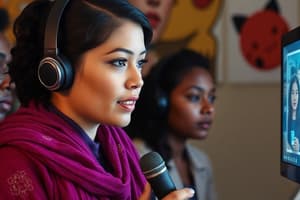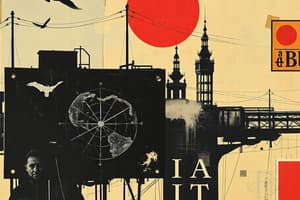Podcast
Questions and Answers
What are viewed as physical objects used to communicate with, or the mass communication through physical objects such as radio, television, computers, film, etc.?
What are viewed as physical objects used to communicate with, or the mass communication through physical objects such as radio, television, computers, film, etc.?
- Literacy
- Information
- Technology
- Media (correct)
What is considered as the ability to access, analyze, evaluate, and create media in a variety of forms?
What is considered as the ability to access, analyze, evaluate, and create media in a variety of forms?
- Information Literacy
- Media Literacy
- Media and Information Literacy (correct)
- Information Technology
What is new media?
What is new media?
- Media that is distributed digitally (correct)
- Media that is transmitted over the airwaves
- Media that is transmitted via satellite
- Media that is printed on paper or other tangible materials
Which of the following literacy is the ability to recognize when information is needed, and to locate, evaluate, and effectively communicate information in its various formats?
Which of the following literacy is the ability to recognize when information is needed, and to locate, evaluate, and effectively communicate information in its various formats?
In the Shannon-Weaver model of communication, what is the function of the channel?
In the Shannon-Weaver model of communication, what is the function of the channel?
Ana is using her computer with mastery of each key position in her computer keyboard. Ana's activity demonstrates which of the following aspects of information and communication literacy?
Ana is using her computer with mastery of each key position in her computer keyboard. Ana's activity demonstrates which of the following aspects of information and communication literacy?
What are some indigenous media sources?
What are some indigenous media sources?
During which period did the power of steam develop machine tools, establish iron production, and manufacture various products, including books through the printing press?
During which period did the power of steam develop machine tools, establish iron production, and manufacture various products, including books through the printing press?
What format/equipment did people use to communicate with each other during the industrial age?
What format/equipment did people use to communicate with each other during the industrial age?
Transistor first appeared in _____?
Transistor first appeared in _____?
Which of the following best describes 'information literacy'?
Which of the following best describes 'information literacy'?
When does someone get copyright protection?
When does someone get copyright protection?
What happens to the work after the copyright time has passed?
What happens to the work after the copyright time has passed?
Something must have the © sign to be copyrighted.
Something must have the © sign to be copyrighted.
What is fair use?
What is fair use?
Non-profit and educational uses will generally weigh in favor of fair use as opposed to?
Non-profit and educational uses will generally weigh in favor of fair use as opposed to?
To locate a book with literary criticisms or biography of Edgar Allan Poe in the library, you perform which search?
To locate a book with literary criticisms or biography of Edgar Allan Poe in the library, you perform which search?
Which of the following is NOT part of a citation?
Which of the following is NOT part of a citation?
A common citation style to be used by students for English classes is _____?
A common citation style to be used by students for English classes is _____?
Which of the following would NOT be considered a primary source material?
Which of the following would NOT be considered a primary source material?
Flashcards are hidden until you start studying
Study Notes
Media Information Literacy
-
Physical objects used for communication include radio, television, computers, and film, collectively known as Media.
-
Media Literacy refers to the ability to access, analyze, evaluate, and create media in various forms, equipping individuals with necessary competencies.
-
New Media is defined as media distributed digitally, contrasting with traditional forms of communication.
-
Information Literacy is the ability to recognize when information is needed and efficiently locate, evaluate, and communicate that information.
-
In the Shannon-Weaver model, the channel transmits the message from sender to receiver, playing a crucial role in communication.
-
Mastering the use of computer keyboards exemplifies proficiency in Information Technology, showcasing practical skills in information and communication literacy.
-
Indigenous media sources include oral histories and storytelling, which are foundational in many cultures.
-
The Industrial Age saw advancements like the printing press, enabling mass production of books and documents.
-
Communication during the Industrial Age relied on devices such as the telegraph, telephone, and motion pictures.
-
The Transistor was first introduced during the Electronic Age, marking significant technological progress.
-
Information literacy encompasses finding reliable information, going beyond merely reading or using computers.
-
Copyright protection is granted automatically upon the creation of a work, not dependent on registration or the © symbol.
-
Upon expiration of copyright, works enter the public domain, where they can be used freely.
-
The © symbol, while helpful in indicating copyright status, is not required for protection; rights exist from creation.
-
Fair Use allows for the limited copying or distribution of works without the author’s permission, provided it adheres to specific guidelines.
-
Non-profit and educational uses typically support fair use, contrasting with Commercial Use, which usually is not favored.
-
When searching for books on specific literary criticisms, utilizing library catalogs is essential for locating relevant materials.
-
A complete citation includes elements such as call number, date, title, and name, aiding in proper referencing.
-
MLA (Modern Language Association) style is commonly adopted by students in English classes for citation purposes.
-
The primary source materials are original documents or first-hand accounts, such as contemporaneous newspaper articles or original research findings.
Studying That Suits You
Use AI to generate personalized quizzes and flashcards to suit your learning preferences.




